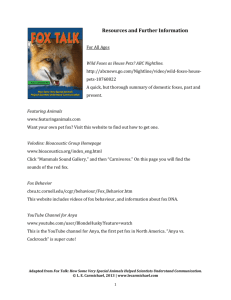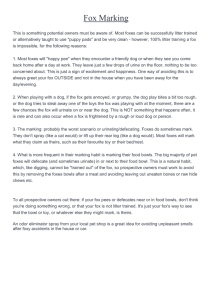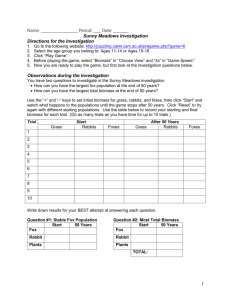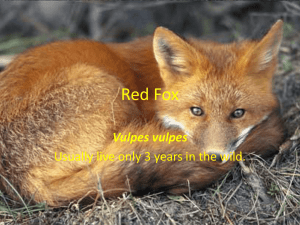NJM_letter_to_ed_TIMES_submitted
advertisement
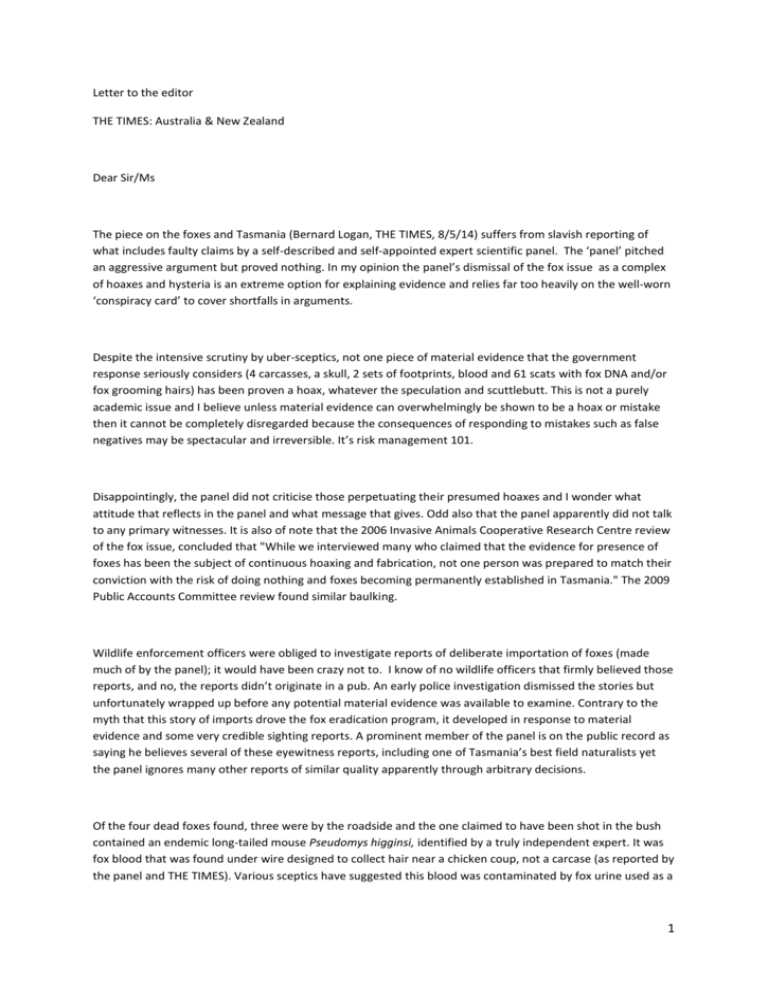
Letter to the editor THE TIMES: Australia & New Zealand Dear Sir/Ms The piece on the foxes and Tasmania (Bernard Logan, THE TIMES, 8/5/14) suffers from slavish reporting of what includes faulty claims by a self-described and self-appointed expert scientific panel. The ‘panel’ pitched an aggressive argument but proved nothing. In my opinion the panel’s dismissal of the fox issue as a complex of hoaxes and hysteria is an extreme option for explaining evidence and relies far too heavily on the well-worn ‘conspiracy card’ to cover shortfalls in arguments. Despite the intensive scrutiny by uber-sceptics, not one piece of material evidence that the government response seriously considers (4 carcasses, a skull, 2 sets of footprints, blood and 61 scats with fox DNA and/or fox grooming hairs) has been proven a hoax, whatever the speculation and scuttlebutt. This is not a purely academic issue and I believe unless material evidence can overwhelmingly be shown to be a hoax or mistake then it cannot be completely disregarded because the consequences of responding to mistakes such as false negatives may be spectacular and irreversible. It’s risk management 101. Disappointingly, the panel did not criticise those perpetuating their presumed hoaxes and I wonder what attitude that reflects in the panel and what message that gives. Odd also that the panel apparently did not talk to any primary witnesses. It is also of note that the 2006 Invasive Animals Cooperative Research Centre review of the fox issue, concluded that "While we interviewed many who claimed that the evidence for presence of foxes has been the subject of continuous hoaxing and fabrication, not one person was prepared to match their conviction with the risk of doing nothing and foxes becoming permanently established in Tasmania." The 2009 Public Accounts Committee review found similar baulking. Wildlife enforcement officers were obliged to investigate reports of deliberate importation of foxes (made much of by the panel); it would have been crazy not to. I know of no wildlife officers that firmly believed those reports, and no, the reports didn’t originate in a pub. An early police investigation dismissed the stories but unfortunately wrapped up before any potential material evidence was available to examine. Contrary to the myth that this story of imports drove the fox eradication program, it developed in response to material evidence and some very credible sighting reports. A prominent member of the panel is on the public record as saying he believes several of these eyewitness reports, including one of Tasmania’s best field naturalists yet the panel ignores many other reports of similar quality apparently through arbitrary decisions. Of the four dead foxes found, three were by the roadside and the one claimed to have been shot in the bush contained an endemic long-tailed mouse Pseudomys higginsi, identified by a truly independent expert. It was fox blood that was found under wire designed to collect hair near a chicken coup, not a carcase (as reported by the panel and THE TIMES). Various sceptics have suggested this blood was contaminated by fox urine used as a 1 lure, stubbornly refusing to accept that the lure was only placed days after the blood was collected. I am no DNA expert but don’t believe in retrospective contamination. Indeed no foxes were shot by the government team but that is hardly surprising since what can only have been a small number of foxes were somewhere in tens of thousands of square km and most focus of the response program was on monitoring and baiting. The poison of choice, 1080, highly toxic to foxes but not so for native carnivores such as Tasmanian devils, does not kick in for hours and poisoned foxes go to ground, likely never to be found. The panel well know this and I think underplaying such probabilities is disingenuous. A number of scats with fox DNA were found within several km of one carcase, none with sufficient quality DNA for genotyping (for a report on this ‘Glen Esk’ fox see the Tasmanian Government DPIPWE website). All carcases have been found by the public and in the poisonous atmosphere of public ridicule by sceptics it is understandable many finders demand anonymity if indeed they report at all. Not so Mr. Bosworth, whose claim of shooting a fox in 2001, a report that has weathered all manner of inquisitions, aligns with what was found neither proving nor disproving the event. The panel’s prolonged criticisms of DNA analysis of scats are, in effect, superficial. They only considered the screening test which its users know can give false positives, not the second, far more sophisticated and accurate sequencing test. The panel criticises the fox scats imported to Tasmania to train dogs and study scat DNA degradation as a source of contamination. However, these scats were very carefully managed separately under strict protocols and professional advice is that the chances of contamination are negligible. It is inconsistent that the panel does not dispute the sighting reports of a fox coming off a ship at Burnie in 1998, an animal that was never found except for footprints several days later, evidence critics have never even asked to see. Yet, THE TIMES saw fit to describe it as a male. In also dismissing the fox found freshly dead on the roadside at Burnie in 2003 as bona fide, the panel must be accepting the anonymous report that it was killed on a ship nearby and dumped. Another inconsistency; the panel glibly dismisses any similar anonymous reports. Such cherry-picking of evidence suggests to me arbitrary investigation or a fixation with local breaches of biosecurity, possibly at the expense of not recognising a more widespread problem, exactly how invasive species get established. I believe a strong response to the evidence was and is both justified and necessary, especially since the Tasmanian devil Sarcophilus harrisii population, our best secondary defence against foxes, is much reduced by disease. Just what that response should have been will always be argued. Detection of very rare animals remains very problematic, something few people seem to understand. The conundrum is stark; if the response was delayed until everyone was satisfied with the evidence it could be too late to mount an eradication program. Had this been the outcome, another self-appointed panel (possibly the same one!) would no doubt have then raised the opposite criticism again with the wisdom of hind-sight and with foxes perhaps established as Tasmania’s worst invasive species . 2 The fox issue in Tasmania is a long tale (no pun intended). The first fox released in Tasmania was in 1864 at Oatlands “...lurchers killing it in Lake Dulverton...”. Other imports reportedly followed in 1890 and in the early 1900s, one involving a claim of two foxes being caught near Scottsdale one being given to the Hobart Zoo (a record of a fox arriving at the zoo corresponds). All manner of stories about later imports exist, some by people claiming to have actually been involved. In 1972 a fox was caught and killed in a rabbit trap at Riverside, duly examined by the then Dept of Agriculture. This has never been questioned despite little or no material evidence remaining. This is in complete contrast to the frenzied critical analysis of every event since that does not fit the local bio-security breach theory. Perhaps a change in public attitude to government is partly to blame for the current uber-scepticism. To make final comment on THE TIMES piece, the response has cost just over $35M not the $50M reported; yes, expensive but the scale of the response is unprecedented. Now vastly reduced, the response has been in a monitoring phase for a year, well before the new conservative State government. Importantly, no material evidence has been found for nearly 2 ½ years – the best possible result. Hopefully that phase will end this episode of what is the ongoing saga of the risk foxes pose to Tasmania. There are literally millions of foxes in nearby Victoria, the frequent traffic across Bass Strait is virtually unregulated and devils will be rare for decades. So, I’m afraid to say, this issue is not going to go away just because it is uncomfortable. 12/5/14 Nick Mooney 2 Torrens St Richmond 7025 Tasmania, AUSTRALIA 61 428886143 <nickjmooney@gmail.com> (While a Tasmanian government wildlife management officer Nick Mooney was attached part time to the government response to fox evidence because of his historic knowledge of fox incursions and wide field experience with Tasmanian wildlife. He left the State service in 2009 and is now independent) 3

